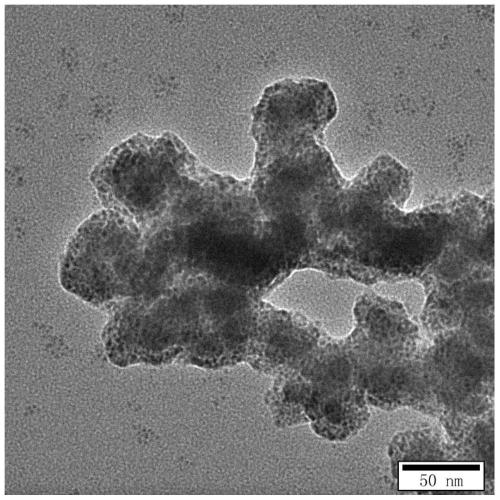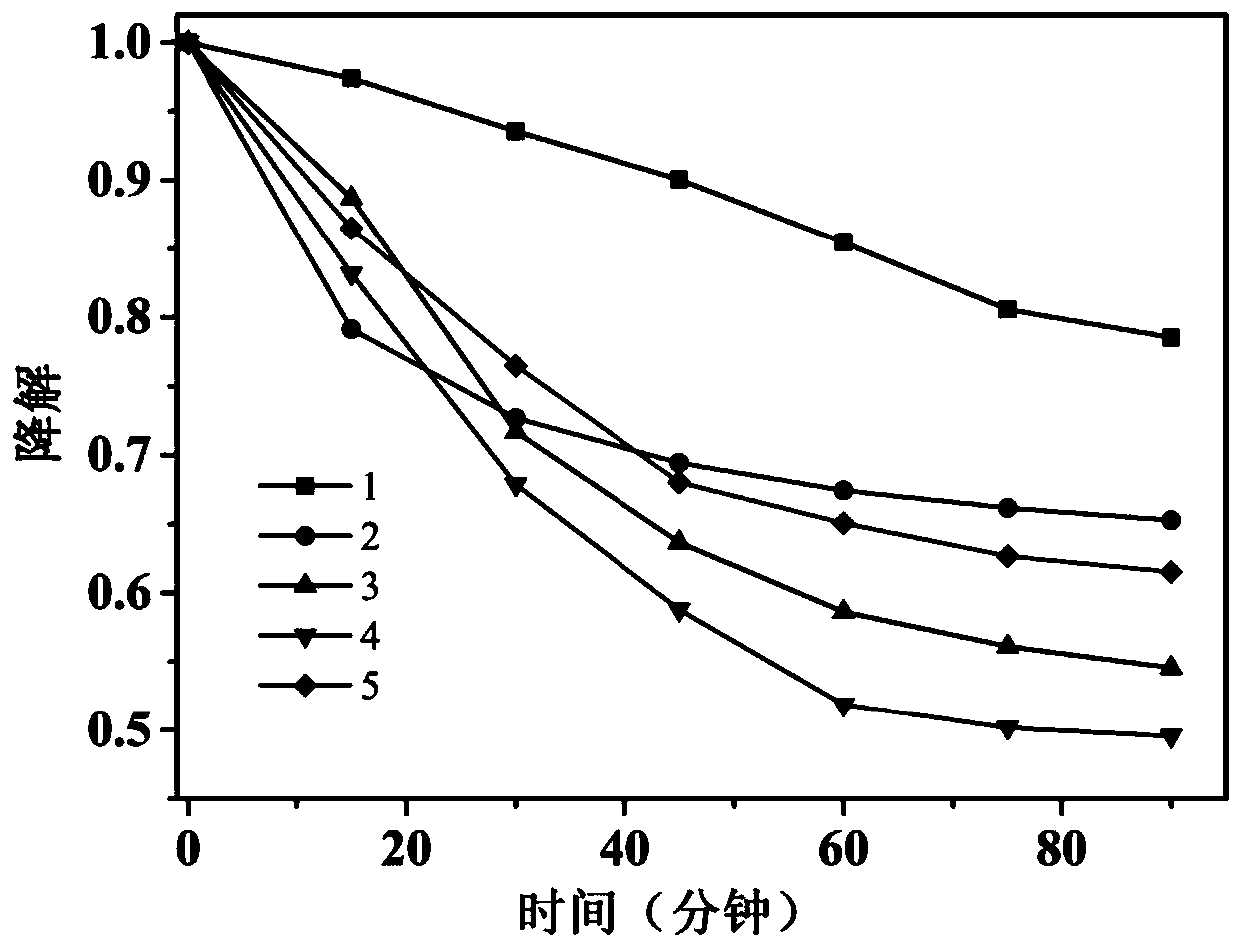Preparation method and application of BiVO4@carbon nanodot composite photocatalytic material
A composite material, carbon nano-dot technology, applied in catalyst activation/preparation, chemical instruments and methods, physical/chemical process catalysts, etc., to achieve the effects of excellent degradation of oxytetracycline hydrochloride, simple and convenient preparation process, and great application prospects.
- Summary
- Abstract
- Description
- Claims
- Application Information
AI Technical Summary
Problems solved by technology
Method used
Image
Examples
Embodiment 1
[0024] Dissolve 0.1170 g ammonium metavanadate in 10 mL 2 mol / L sodium hydroxide solution to make mixed solution A, and dissolve 0.4851 g bismuth nitrate pentahydrate and 0.25 g sodium dodecylbenzenesulfonate in 10 mL Prepare mixed solution B in 4 mol / L nitric acid solution, mix mixed solution A and mixed solution B evenly, adjust pH=6 with 2 mol / L sodium hydroxide solution, and obtain BiVO 4 Precursor; 0.01 g of sodium lignosulfonate was added to the prepared BiVO 4 In the precursor, stir to completely dissolve the sodium lignosulfonate, transfer the obtained mixed solution to a reaction kettle for calcination at 200 °C for 8 hours, then centrifugally wash the obtained solid, and dry it to obtain BiVO 4 @Carbon Nanodot Composites.
[0025] Photocatalytic degradation test: the obtained BiVO 4 @Carbon nano-dot composite material was tested for photocatalytic degradation in a photochemical reaction instrument, and the BiVO 4 The degradation rate of oxytetracycline hydrochlori...
Embodiment 2
[0027] Dissolve 0.1170 g ammonium metavanadate in 10 mL 2 mol / L sodium hydroxide solution to make mixed solution A, and dissolve 0.4851 g bismuth nitrate pentahydrate and 0.25 g sodium dodecylbenzenesulfonate in 10 mL Prepare mixed solution B in 4mol / L nitric acid solution, mix mixed solution A and mixed solution B evenly, adjust pH=8 with 2mol / L sodium hydroxide solution, and obtain BiVO 4 Precursor; 0.05 g of sodium lignosulfonate was added to the prepared BiVO 4 In the precursor, stir to completely dissolve the sodium lignosulfonate, transfer the obtained mixed solution to a reaction kettle for calcination at 160 °C for 16 hours, then centrifugally wash the obtained solid, and dry it to obtain BiVO 4 @Carbon Nanodot Composites.
[0028] Photocatalytic degradation test: the obtained BiVO 4 @Carbon nano-dot composite material is placed in a photochemical reaction instrument for photocatalytic degradation test, and the BiVO 4 The degradation rate of oxytetracycline hydrochl...
Embodiment 3
[0030] Dissolve 0.1170 g ammonium metavanadate in 10 mL 2 mol / L sodium hydroxide solution to make mixed solution A, and dissolve 0.4851 g bismuth nitrate pentahydrate and 0.25 g sodium dodecylbenzenesulfonate in 10 mL Prepare mixed solution B in 4 mol / L nitric acid solution, mix mixed solution A and mixed solution B evenly, adjust pH=7 with 2 mol / L sodium hydroxide solution, and obtain BiVO 4 Precursor; Add 0.10 g of sodium lignosulfonate to the prepared BiVO 4 In the precursor, stir to completely dissolve the sodium lignosulfonate, transfer the obtained mixed solution to a reaction kettle for calcination at 160 °C for 16 hours, then centrifugally wash the obtained solid, and dry it to obtain BiVO 4 @Carbon Nanodot Composites.
[0031] Photocatalytic degradation test: the prepared BiVO 4 @Carbon nano-dot composite material is placed in a photochemical reaction instrument for photocatalytic degradation test, and the BiVO 4 The degradation rate of oxytetracycline hydrochlorid...
PUM
 Login to View More
Login to View More Abstract
Description
Claims
Application Information
 Login to View More
Login to View More - R&D
- Intellectual Property
- Life Sciences
- Materials
- Tech Scout
- Unparalleled Data Quality
- Higher Quality Content
- 60% Fewer Hallucinations
Browse by: Latest US Patents, China's latest patents, Technical Efficacy Thesaurus, Application Domain, Technology Topic, Popular Technical Reports.
© 2025 PatSnap. All rights reserved.Legal|Privacy policy|Modern Slavery Act Transparency Statement|Sitemap|About US| Contact US: help@patsnap.com



